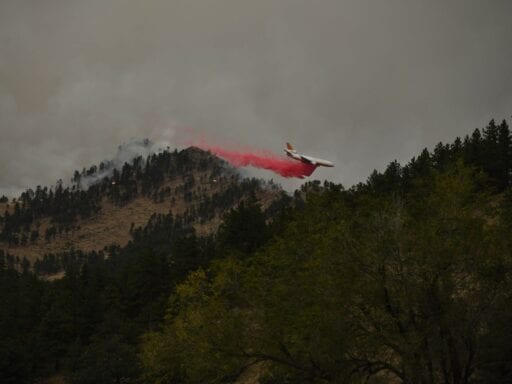The previous record-holding fire was contained just seven weeks ago, and new fires continue to erupt.
The Cameron Peak Fire near Rocky Mountain National Park has become the largest wildfire in Colorado history, growing to 203,000 acres this weekend. The fire was 62 percent contained as of Monday morning.
This is just heartbreaking. #loveland #cameronpeak #CameronPeakFire #ColoradoFires #colorado #pray pic.twitter.com/Kdpt7oSEtQ
— Eugene (@MountianManD) October 18, 2020
The previous record-holder was the 137,000-acre Pine Gulch Fire near Grand Junction, Colorado. That fire also ignited this year and was declared 100 percent contained in September. It only held on to its record as Colorado’s largest wildfire for seven weeks.
Meanwhile, another new, fast-moving wildfire ignited in Boulder County on Saturday and quickly spread across almost 9,000 acres, forcing at least 3,000 people to evacuate. Known as the CalWood Fire, it’s now the largest wildfire on record for Boulder County. Then on Sunday, the Lefthand Canyon Fire started just outside of Boulder.
Beyond the threat from the flames, these various wildfires have sent dangerous, smoky air into cities like Denver and Fort Collins, triggering air quality alerts off and on for months.
Together, the recent blazes in Colorado add up to an unusually long and severe wildfire season, and it’s not likely to let up anytime soon. “The current fire season, it’s definitely a crazy one,” said Chad Hoffman, an associate professor of fire science at Colorado State University. “We still have dry, windy conditions pushing these fires.”
Some unique weather conditions this year set the stage for Colorado’s blazes, but the threat from wildfires is growing across the state due to human development and climate change.
What’s fueling Colorado’s fires this year
It’s an increasingly familiar story. Like the epic wildfires this year across California, Oregon, and Washington, the wildfires in Colorado arose amid a year of extreme heat and dryness.
Heat waves baked the state this summer and persisted into the fall. The high temperatures increased the evaporation of moisture from vegetation, leaving plants dry and ready to burn. There was also less rainfall. Over the past month, precipitation was less than 10 percent of what is typical.
“By the end of September, nearly 100% of the state was experiencing some level of drought, up from 51% since the beginning of the calendar year,” according to the Colorado Climate Center’s Monthly State of the Climate report. The state is on track to have its second-driest year on record.
That aridity has left almost every type of vegetation in the state primed to burn, as was evident in the Cameron Peak Fire. “It burned all the way from fir forest, ponderosa pine, mixed conifer. It’s burned through some grasslands and shrublands as well,” Hoffman said. “It’s burned through areas that have previously burned, like during the Bobcat Fire. It’s burned through bark-beetle-affected areas. So a really big mix of fuels that this fire has burned through over the last 60 days.”
It’s also uncommon to see fires this late in the year in Colorado. Typically winter precipitation starts to set in and cap fire seasons in the autumn.
This fits within the trend of fire seasons in Colorado getting longer. Wildfires are a natural part of the landscape in the state, as they are in places farther west. Many woodlands have evolved to deal with and benefit from periodic fires.
However, humans have been making fire risks worse. That’s in part due to climate change, which is changing weather patterns and driving some of the aridity in Colorado’s forests. It’s also a function of more people living in high-risk areas. “The growing population in Colorado means we have more people in the woods, which leads potentially to more ignitions,” Hoffman said. The vast majority of wildfires in the United States have human causes, though in Colorado about half of fires in the state are ignited by lightning strikes.
The growing fire risk is also a consequence of more than a century of suppression of natural wildfires. By putting out blazes, vegetation in the state has accumulated, so during periods of extreme dryness, there is much more fuel to burn than there would be had more fires been allowed to proceed.
There are now efforts to reintroduce fire to the landscape, but vast swaths of the state need fuel reduction treatments, and the window for safely conducting measures like prescribed burns is shrinking as the climate warms.
This video gives a quick look into the types of wind conditions us and other firefighters on Cameron Peak experienced and have been experiencing over the duration of the #cameronpeakfire #cofire pic.twitter.com/8WDfE1reTc
— COFirePrev&Control (@COStateFire) October 19, 2020
For now, firefighters are facing high winds as they work to contain Colorado’s record-breaking blazes. And until the winds slow and the snow and rain arrive, the fires in the state are poised to continue burning — and more may yet ignite.
Millions turn to Vox each month to understand what’s happening in the news, from the coronavirus crisis to a racial reckoning to what is, quite possibly, the most consequential presidential election of our lifetimes. Our mission has never been more vital than it is in this moment: to empower you through understanding. But our distinctive brand of explanatory journalism takes resources. Even when the economy and the news advertising market recovers, your support will be a critical part of sustaining our resource-intensive work. If you have already contributed, thank you. If you haven’t, please consider helping everyone make sense of an increasingly chaotic world: Contribute today from as little as $3.
Author: Umair Irfan
Read More



